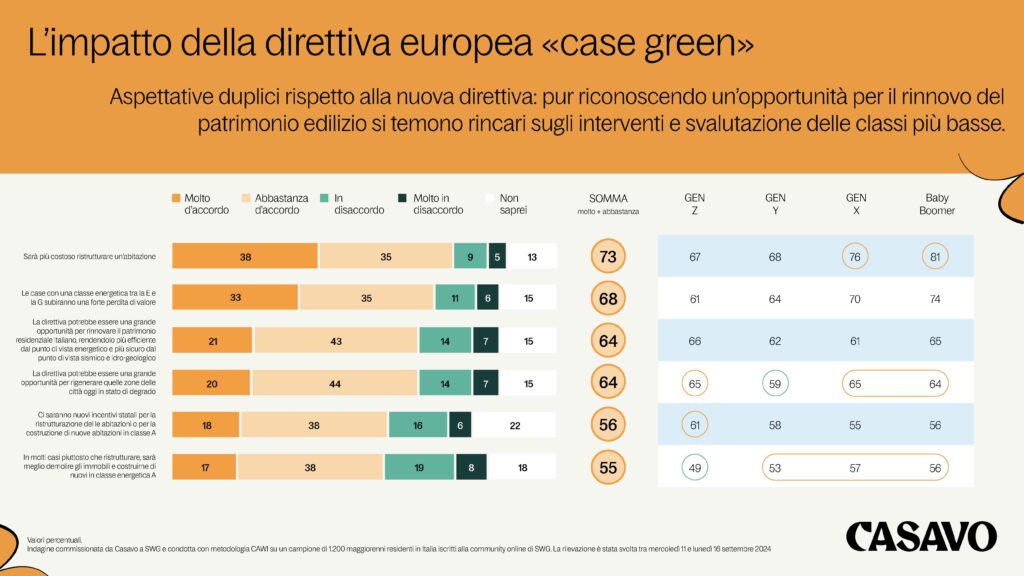Index
- According to a Casavo survey, 1 in 2 Italians considers the reduction of energy consumption the main advantage of green building. 1 in 4 indicates the lower environmental impact
- Among the obstacles, the excessively high initial costs (56%) and bureaucratic delays (33%)
- To facilitate the buying and selling process, Casavo has developed a new version of its evaluation model that integrates the energy class variable
***
Milan, 2 October 2024 – The European Green Homes Directive aims to improve the energy efficiency of residential buildings (which will have to reach class E by 2030 and class D by 2033), inviting member countries to renovate properties to reduce CO2 emissions. The directive intends to combat climate change and reduce energy consumption. Furthermore, it provides for the introduction of green building practices through the use of eco-friendly technologies and materials.
Casavo, a company that offers smart solutions for buying and selling homes, wanted to investigate what Italians think of the introduction of the recent green policy, especially in light of a currently rather old residential stock, 51% of which falls into energy classes F and G.
Green homes: for Italians, focus on costs
According to the results of the research commissioned by SWG, Italians seem to have dual expectations regarding the new directive: while recognizing an opportunity for the renovation of the residential stock (64% of Italians think so), they fear price increases on interventions and devaluation of the lower classes. In fact, 73% think it will be more expensive to renovate a home (a figure up 7% compared to 2023). Furthermore, 68% think that homes with an energy class between E and G will suffer a significant loss of value.
To facilitate the buying and selling process and meet market needs, Casavo has developed a new version of its valuation model, which starts today with the energy class variable. From the platform data, Casavo finds that, while in the past the energy class field was rarely filled in, in the last year 34% of sellers have valued a property in class A, B, C or D (and 1 in 3 still hasn't filled in this field). A trend that demonstrates users' growing awareness of green issues.
Green construction: 1 in 2 Italians thinks about reducing consumption
The response to environmental and energy needs also involves green construction, which, among other things, involves the use of sustainable materials and the reduction of the use of polluting or health-damaging materials. 1 in 2 Italians considers the reduction in energy consumption to be the main advantage of this practice, while almost 1 in 4 (23%) indicates the lower environmental impact, an aspect that is most preferred by Generation Z (32%) and Millennials (37%).
Among the main obstacles to adopting this type of sustainable building, 56% of respondents indicate excessive initial costs. In second place are difficulties and bureaucratic delays (33%) and the lack of government incentives (26%).
The "green homes" directive poses a significant challenge, but also offers a great opportunity to modernize our residential stock. These are projects that not only reduce pollution, but also guarantee long-term economic savings and improve living comfort,” comments Victor Ranieri, Chief Revenue Officer of Casavo. “However, the data shows us that there is no shortage of concerns, especially among the more mature segments of the population. On the contrary, those most sensitive to environmental issues remain young people. Another concern is linked to the devaluation of the existing real estate stock. To date, this aspect has not yet had a tangible impact on prices, but it is embodied in an increase in searches oriented towards new, renovated or high energy class properties, to protect a future investment.”
“Through our data, in fact, we are already noticing greater interest from buyers in renovated properties that meet energy efficiency criteria. This is also why we have worked on the new integration of our evaluation model. As Casavo, we are committed to being ever closer to the requests and needs of the market and the users themselves,” concludes Ranieri.

